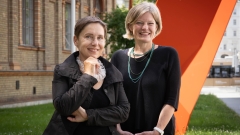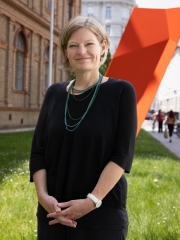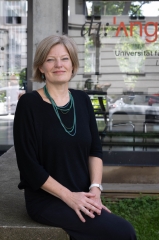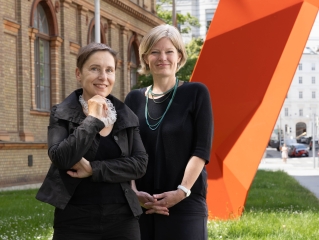Martina
Griesser-Stermscheg will be the new professor of conservation and restoration and will take over as head of the institute
on October 1, 2024
23. July 2024
The Institute of Conservation
combines the past, present and future, linking knowledge and practices from the arts and sciences. “I am looking forward to
working with students, teachers, graduates and many project partners in a field that I cannot imagine being more exciting,
fascinating and diverse,” said the future professor in her first statement.
Griesser-Stermscheg
presents four key areas as future plans for the five-year diploma program and for the international joint master's program:
The first focus is on the consequences of the climate crisis, which is massively changing the field of museums and heritage
conservation and, more than ever, is demanding green skills and preventive methods as well as new approaches in research and
teaching.
The second focus is on expanding materials science, which is established at the institute, to include material
culture studies. This involves, in particular, the critical analysis and visualization of the cultural significance of materials
and of contemporary working and production conditions. The third focus is on the equal transfer of knowledge in international
project work, which the institute has been successfully doing for many years. In this context, Griesser-Stermscheg focuses
on the limits of the European-influenced tradition of values and preservation in the field of Intangible Heritage and on the
topic of the “living use” of cultural assets from non-European contexts. And fourthly, it is important to harmonize university
teaching with UNESCO's guidelines on Digital Heritage Preservation. At present, the profiles of born-digital and software
collections are determined primarily by basic research in conservation and technical possibilities, and thus by the cultural
memory of future retrospectives on the first decades of the digital age. Enormous efforts are needed in the field of the arts
to avoid losing the race against time and to seek and find complex, experimental and innovative solutions.
The
University of Applied Arts Vienna is not a stranger to Martina Griesser-Stermscheg: She has been part of the management team
for the exhibition theory and practice program ecm – educating/curating/making since 2006. From 2001 to 2013, she worked at
the Institute for Conservation and Restoration at the University of Applied Arts Vienna, where she also completed her doctorate
and habilitation. Until her move to the University of Applied Arts Vienna, the Salzburg-born Griesser-Stermscheg was head
of the research institute at the Technical Museum Vienna, where she played a key role in its development. Before taking up
her post at the Technical Museum Vienna, where she has also been deputy scientific director since 2020, she contributed her
expertise to MUSA, the City of Vienna's collection of contemporary art. Her profile is rounded off by numerous research projects,
an extensive list of publications, lectures, conferences and workshops, in which teaching and supervising academic work also
play a major role. Last but not least, Griesser-Stermscheg is also familiar with the field of exhibition curating.
Martina Griesser-Stermscheg is taking over the management of the institute from Gabriela Krist, who has successfully managed
it since 1999 and is now retiring.







